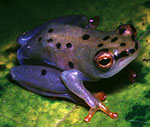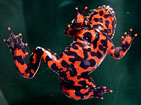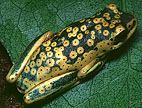|
||||||||||||
|
There are over 3,000 different species of frogs and toads, sporting just about every color in the rainbow. Shades of leafy green and muddy brown are naturally most common -- these colors help frogs blend in with their surroundings. Solomon Island leaf frogs take camouflage to a higher level: they have both the color and pointed shape of dry leaves, making them virtually impossible to find on leaf-strewn ground. |
||||||||||||
Not
all frogs try to blend in. Especially in the tropics, there are wildly
colored frogs of yellow, blue, orange, red, and purple, often patterned
with bold stripes and spots. These bright colors serve as a warning
to predators: "Don't eat me; I'm poisonous." In this regard, frogs aren't
above bluffing. Some nonpoisonous species of frogs have adopted the
colors of poison dart frogs to trick predators into giving them a wide
berth they don't deserve.
Many frogs that look dull
and unassuming at first have what are called "flash colors"--hidden
patches of bright color or patterns on their bellies, groins, or the
backs of their thighs. For example, the plain brown back of the fire-bellied
toad matches the ground on which it spends most of its time. When threatened,
the toad exposes its bright red underside. Surprising displays of this
kind can startle or confuse predators into fleeing, or at least buy
the frog some time in which to make an escape.
The
Chilean four-eyed frog is most deviously colored. It has a bright pair
of spots on its rump that look like enormous eyes. When seated, the
frog's thighs conceals these eyespots. But when predators approach,
the frog lowers its head and lifts its rump, creating the illusion of
a much larger and more intimidating head.
Some frogs can change their
color, chameleon-like, according to light, temperature, humidity, or
even mood. Fear or excitement makes many frogs and toads turn pale,
but others, like the African clawed frog, darken when disturbed. Another
African frog is normally green, but turns white in the heat of the day
to reflect heat and keep cool. The tiny African arum frog is ivory white
and lives in the white blossoms of the arum swamp lily. When the blossoms
die, the frogs turn brown to match.
|
||||||||||||
Color
changes like this are created by special pigment cells called chromatorphores.
Inside these cells, grains of pigment cause color changes by shifting
their distribution. When the grains are packed together in the center
of each cell, the frog is light colored. When the pigment grains spreads
out within each cell, the frog's color darkens and intensifies.
|
||||||||||||
© 1999, The Exploratorium |



